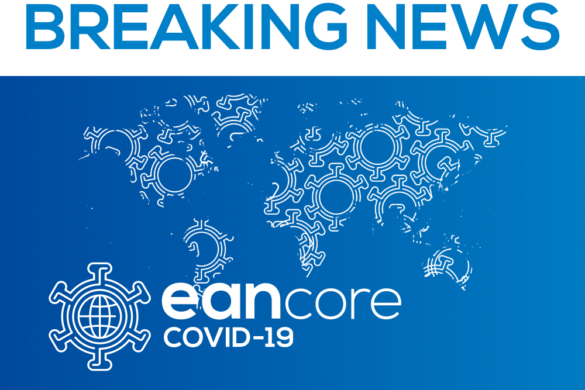The European Academy of Neurology’s named lectures are named after three outstanding European neurologists and are reserved for outstanding active basic and clinical scientists. The awardees are selected by the EAN.
Acting President of the EAN, Prof. Claudio Bassetti, introduced the session together with co-chair Christine Tranchant. They welcomed the participants from all over the world and thanked them for their support. The Mortiz-Romberg lecture was given by Giorgio Cruccu, who is a full Professor of Neurology at the University of Rome, Chairman of the Neurology Teaching Course for the Degree in Medicine and Chief of the Clinical Neurophysiology Division and associated Neuropathic Pain Centre. The title of his lecture was: “Pain and neurologists: never too late”. He thanked EAN for awarding him with this lecture. In his presentation, he explained that pain is a major issue worthy of clinical and research effort and a difficult but crucial topic. He elaborated on the impact of chronic pain, which has become the highest source of costs for the national health services in Europe. He pointed out that there is great difficulty in trying to measure pain and not many have succeeded in doing so. The best thing is to ask the patient to tell the physician on a linear or graded scale how they would define their pain. This way, although results cannot really be compared between subjects, there is value within-subject. He showed the different types of sensory nerve endings and elaborated on the central pathways and the modulating descending systems. He presented functional MRI experiments from Oxford which have shown the difficulty in reproduce the experience of a patient who is in pain. Chronic pain transforms into more generalised suffering, with involvement of emotional areas and overlap between areas involved in pain and depression. Prof. Cruccu presented the five classes of pain (nociceptive, neuropathic, psychogenic, mixed and multialgodysfunctional). As an example of multialgodysfunctional pain, the lecturer elaborated on fibromyalgia, which mostly affects women. Prof. Cruccu expanded on the subject of testing by talking about Qualitative Sensory Testing (QST) and small-fibre pathology in order to try to reproduce valid results.
The Brain Prize is the world’s largest brain research prize and, at this year’s 6th EAN congress, the Brain Prize lecture was delivered by Hugues Chabriat, Head of the Neurology Department at the University Hospital Lariboisiere in Paris and Coordinator of the National Centre for Rare Neurovascular Disorders in France. His lecture was titled: “CADASIL: yesterday, today, tomorrow.” Prof. Chabriat took the participants on a journey over 30 years of research regarding this disorder, which started with the observation of a 55-year-old patient with an unknown disease in 1976, that would only be identified nearly 20 years later in 1993, when data from a family kindred allowed location of the NOTCH3 gene mutation causing CADASIL on chromosome 19. Now, over 1100 mutations have been identified in families from France, and the disease has been described all over the world. At clinical level, gene identification has led to accurate diagnosis, and was followed by development of biomarkers and characterisation of the CADASIL phenotype including the natural history of the associated ischaemic small vessel disease. In 2008, a randomised clinical trial of donepezil vs. placebo was performed to address the cognitive impairment. Brain atrophy, lacunar infarcts and microstructural changes all impact on cognition and disability in CADASIL. Accumulating evidence suggests distinct underlying mechanisms underpin the observed white matter hyperintensities with differing clinical consequences. Prof. Chabriat further elaborated on the paths to be taken through translational research to develop therapeutics, and underlined that the CADASIL story illustrates a true model of translational research, from bench to bedside and vice versa.
The Charles Edouard Brown-Sequard Lecture was held by Prof. Steve Laureys, who is the Head of the Coma Science Group at Sart Tilman Liége University in Belgium and is Clinical Professor and Research Director of the Belgian National Fund of Scientific Research. His lecture was titled “Coma and chronic disorders of consciousness: in need of better neurological understanding and care”. Prof. Laureys extended the honour of this lecture to his whole team for translating knowledge into better care and invited everyone to read the AAN and the European guidelines on this topic. He aimed to review what consciousness is, what we know about it and how to translate that knowledge into better patient care. In the past, there has been a prevalent view of consciousness as something that is all or nothing which led to labels in impaired patients such as vegetative state. Since then, many studies have challenged this notion, and the term unresponsive wakefulness is now preferred. He explained that to talk about consciousness, we must first consider two distinct aspects: wakefulness and awareness. Furthermore, awareness can be split into sensory (external) awareness and internal awareness. He pointed out that there is still much work to be done in terms of peer-reviewed papers regarding this subject. Prof. Laureys explained the global workspace and information integration theories, in relation to patients who are in unresponsive states. Furthermore, he emphasised the importance of repetitive testing (at least five times), as a single test cannot determine whether a patient is in unresponsive wakefulness or a minimally conscious state.












